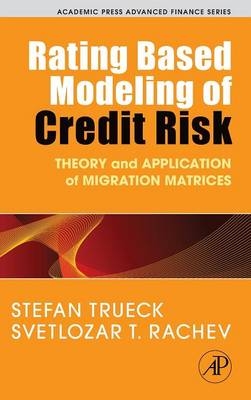
Rating Based Modeling of Credit Risk
Academic Press Inc (Verlag)
978-0-12-373683-3 (ISBN)
In the last decade rating-based models have become very popular in credit risk management. These systems use the rating of a company as the decisive variable to evaluate the default risk of a bond or loan. The popularity is due to the straightforwardness of the approach, and to the upcoming new capital accord (Basel II), which allows banks to base their capital requirements on internal as well as external rating systems. Because of this, sophisticated credit risk models are being developed or demanded by banks to assess the risk of their credit portfolio better by recognizing the different underlying sources of risk. As a consequence, not only default probabilities for certain rating categories but also the probabilities of moving from one rating state to another are important issues in such models for risk management and pricing.
It is widely accepted that rating migrations and default probabilities show significant variations through time due to macroeconomics conditions or the business cycle. These changes in migration behavior may have a substantial impact on the value-at-risk (VAR) of a credit portfolio or the prices of credit derivatives such as collateralized debt obligations (D+CDOs). In Rating Based Modeling of Credit Risk the authors develop a much more sophisticated analysis of migration behavior. Their contribution of more sophisticated techniques to measure and forecast changes in migration behavior as well as determining adequate estimators for transition matrices is a major contribution to rating based credit modeling.
Svetlozar (Zari) Rachev completed his PhD in 1979 from Moscow State University, and his Doctor of Science degree in 1986 from the Steklov mathematical Institute in Moscow. Currently he is Chair-Professor at the University of Karlsruhe in the School of Economics and Business Engineering. He is also Professor Emeritus at the University of California Santa Barbara in the Dept of Statistics and Applied Probability. He has published six monographs and over 230 research articles. He is a Fellow of the Institute of Mathematical Statistics, Elected member of the International statistical Institute, foreign Member of the Russian Academy of Natural Science, and hols an honorary doctorate degree from St. Petersburg Technical University. He is co-founder of Bravo Risk Management Group specializing in financial risk management software. Bravo Group was recently acquired by FinAnalytics for which he currently serves as Chief-Scientist.
1. Introduction: Credit Risk Modeling, Ratings and Migration Matrices
2. Rating and Scoring Techniques
3. The New Basel Capital Accord
4. Rating Based Modeling
5. Migration Matrices and the Markov Chain Approach
6. Stability of Credit Migrations
7. Measures for Comparison of Transition Matrices
8. Real World and Risk-Neutral Transition Matrices
9. Conditional Credit Migrations: Adjustments and Forecasts
10. Dependence Modeling and Credit Migrations
11. Credit Derivatives
| Erscheint lt. Verlag | 15.1.2009 |
|---|---|
| Reihe/Serie | Academic Press Advanced Finance Series |
| Verlagsort | San Diego |
| Sprache | englisch |
| Maße | 152 x 229 mm |
| Gewicht | 580 g |
| Themenwelt | Betriebswirtschaft / Management ► Spezielle Betriebswirtschaftslehre ► Bankbetriebslehre |
| ISBN-10 | 0-12-373683-8 / 0123736838 |
| ISBN-13 | 978-0-12-373683-3 / 9780123736833 |
| Zustand | Neuware |
| Haben Sie eine Frage zum Produkt? |
aus dem Bereich


